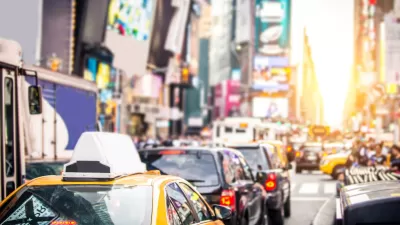NYT reporter Amy O'Leary observes Manhattan's ubiquitous construction while suffering through overcrowded sidewalks, stores, and subway trains, and wonders just how many more people the crowded borough can absorb.
O'Leary provides a historical basis just in case the reader thinks the crowds are intolerable now. She reports that Manhattan had been much more crowded in 1910 when a "staggering 2.3 million people crowded the borough, mostly in tenement buildings. It was a time before zoning, when roughly 90,000 windowless rooms were available for rent..."
Then came "1980, with the subsequent flight to suburbia, the population fell to 1.4 million." The 2010 population is 1.586 million.
Sky's the limit.
Most interesting is the perspective of "Ed Glaeser, a Harvard economist, (who) inevitably comes up in conversations about how cities should grow. In his recent book, "Triumph of the City," he makes an argument - which many consider persuasive - that dense places are uniformly better and more interesting than emptier ones, and that they should be allowed to develop unfettered, even if it means building towers where brownstones once stood."
"Affordability is the first reason. If you build up, he says, housing prices will fall and more people will be able to live in their own sliver of Manhattan sky. And that's a good thing, Mr. Glaeser adds, since the energy of all those newcomers will fuel innovation and entrepreneurship, attracting talent and growth to create a virtuous circle. From energy-efficiency to life expectancy to finding a date or something to do on a Saturday night, Mr. Glaeser argues that denser places have the edge."
Thanks to Mark Boshnack
FULL STORY: Everybody Inhale: How Many People Can Manhattan Hold?

Trump Administration Could Effectively End Housing Voucher Program
Federal officials are eyeing major cuts to the Section 8 program that helps millions of low-income households pay rent.

Planetizen Federal Action Tracker
A weekly monitor of how Trump’s orders and actions are impacting planners and planning in America.

Ken Jennings Launches Transit Web Series
The Jeopardy champ wants you to ride public transit.

Rebuilding Smarter: How LA County Is Guiding Fire-Ravaged Communities Toward Resilience
Los Angeles County is leading a coordinated effort to help fire-impacted communities rebuild with resilience by providing recovery resources, promoting fire-wise design, and aligning reconstruction with broader sustainability and climate goals.

When Borders Blur: Regional Collaboration in Action
As regional challenges outgrow city boundaries, “When Borders Blur” explores how cross-jurisdictional collaboration can drive smarter, more resilient urban planning, sharing real-world lessons from thriving partnerships across North America.

Philadelphia Is Expanding its Network of Roundabouts
Roundabouts are widely shown to decrease traffic speed, reduce congestion, and improve efficiency.
Urban Design for Planners 1: Software Tools
This six-course series explores essential urban design concepts using open source software and equips planners with the tools they need to participate fully in the urban design process.
Planning for Universal Design
Learn the tools for implementing Universal Design in planning regulations.
Ada County Highway District
Clanton & Associates, Inc.
Jessamine County Fiscal Court
Institute for Housing and Urban Development Studies (IHS)
City of Grandview
Harvard GSD Executive Education
Toledo-Lucas County Plan Commissions
Salt Lake City
NYU Wagner Graduate School of Public Service





























